Click on images to enlarge
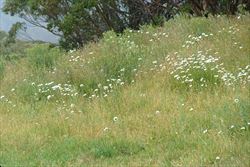
infestation (Photo: Sheldon Navie)
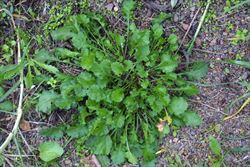
habit prior to flowering (Photo: Trevor James)
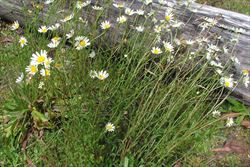
habit in flower (Photo: Sheldon Navie)
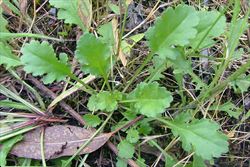
lower leaves borne on long stalks (Photo: Sheldon Navie)
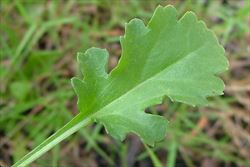
close-up of lower leaf (Photo: Sheldon Navie)
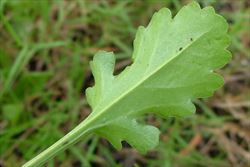
close-up of leaf underside (Photo: Sheldon Navie)

close-up of stem and stalkless upper leaf (Photo: Sheldon Navie)
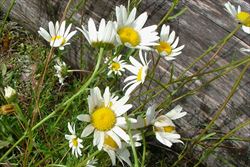
flower-heads (Photo: Sheldon Navie)
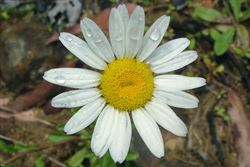
flower-head (Photo: Sheldon Navie)

close-up of flower-head (Photo: Trevor James)

close-up of flower-head from side-on, showing floral bracts (Photo: Greg Jordan)
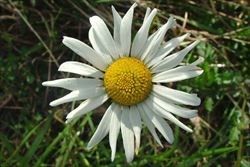
older flower-head (Photo: Sheldon Navie)

close-up of seeds (Photo: Steve Hurst at USDA PLANTS Database)
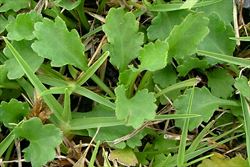
young plants (Photo: Sheldon Navie)
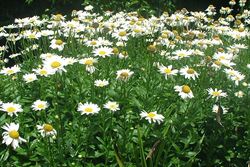
Shasta daisy, Leucanthemum maximum (Photo: Sheldon Navie)
Scientific Name
Leucanthemum vulgare Lam.
Synonyms
Chrysanthemum leucanthemum L.Chrysanthemum leucanthemum L. var. pinnatifidum Lecoq & Lam.Leucanthemum leucanthemum (L.) Rydb.
Family
Asteraceae (Queensland, New South Wales, the ACT, Victoria, Tasmania, Western Australia and the Northern Territory)Compositae (South Australia)
Common Names
dog daisy, field daisy, marguerite, marguerite daisy, mid-summer daisy, moon daisy, moon-penny, ox-eye daisy, oxeye daisy, poor-land flower, poverty weed, white daisy, white weed, yellow daisy
Origin
This species originated in Europe (i.e. the UK, France, Denmark, Sweden, Austria, Czechoslovakia, Germany, Hungary, Switzerland, Greece, Italy, Romania, the Ukraine and western Russia) and western Asia (i.e. Turkey and Georgia).
Cultivation
Ox-eye daisy (Leucanthemum vulgare) has been widely cultivated as a garden ornamental, particularly in temperate regions.
Naturalised Distribution
Widely naturalised in the wetter parts of south-eastern Australia (i.e. in eastern New South Wales, the ACT, southern and eastern Victoria, Tasmania and south-eastern South Australia). Possibly also sparingly naturalised in south-western Western Australia.
Widely naturalised in other parts of the world.
Habitat
A weed of disturbed sites, waste areas, roadsides, pastures, grasslands and open woodlands in the wetter temperate regions of Australia.
Habit
An upright (i.e. erect) and long-lived (i.e. perennial) herbaceous plant usually growing 30-60 cm tall, but occasionally reaching up to 1 m in height.
Distinguishing Features
- an upright and long-lived herbaceous plant with sparsely branched stems usually growing 30-60 cm tall.
- its leaves are alternately arranged along the stems, but form a basal rosette during the early stages of growth.
- the rosette leaves are stalked and have slightly toothed to lobed margins, while the upper stem leaves are smaller, narrower, and usually stalkless with toothed margins.
- its flower-heads (2-6 cm across) are like a typical 'daisy' with numerous white 'petals' and a yellow centre.
- these flower-heads give rise to numerous small ribbed 'seeds' (about 2.5 mm long).
Stems and Leaves
The stems are sometimes densely hairy (i.e. pubescent) towards the base of the plant, but are sparsely hairy or hairless (i.e. glabrous) towards the top of the plant. They are slightly grooved and sparsely branched.
The leaves are slightly hairy (i.e. puberulent) or hairless (i.e. glabrous) and alternately arranged along the stems, but form a basal rosette during the early stages of growth. The lower leaves are relatively large (4-15 cm long and up to 5 cm wide), stalked (i.e. petiolate), and have slightly toothed (i.e. serrate) and/or lobed margins. Upper leaves are smaller (up to 7.5 cm long), narrower, and usually stalkless (i.e. sessile) with deeply toothed (i.e. serrate) margins.
Flowers and Fruit
The flower-heads (i.e. capitula) are like a typical 'daisy' and have numerous (15-40) white 'petals' (i.e. ray florets) surrounding a yellow centre. These 'petals' (i.e. ray florets) are 10-20 mm long and the yellow centre consists of many tiny tubular flowers (i.e. disc florets), each about 3 mm long. The flower-heads (2-6 cm across) are borne singly at the tips of the branches and their bases are surrounded by several overlapping rows of green bracts (i.e. involucral bracts) with brownish coloured margins. Flowering occurs mostly during late spring and early summer.
The small and narrow 'seeds' (i.e. achenes) are either dark brown, black or grey in colour. These 'seeds' (1-3 mm long) have ten prominent lengthwise (i.e. longitudinal) 'ribs' but are not topped with any scales or hairs (i.e. they have no pappus).
Reproduction and Dispersal
This species reproduces from seed and also vegetatively via creeping underground stems (i.e. rhizomes) that give rise to new shoots.
Seeds may be spread by water, animals, vehicles and in contaminated agricultural produce. Underground stem (i.e. rhizome) fragments may be spread during processes involving soil movement, such as cultivation and road maintenance activities.
Environmental Impact
Ox-eye daisy (Leucanthemum vulgare) is regarded as an environmental weed in Victoria and Tasmania.
Legislation
This species is declared under legislation in the following states and territories:
- Victoria: P1 - prohibited and must be eradicated or controlled (in the Corangamite region), and C4 - all reasonable steps must be taken to control the weed and prevent its spread (in the Goulburn, North East, West Gippsland and East Gippsland regions).
- Western Australia: Unassessed - this species is declared in other states or territories and is prohibited until assessed via a weed risk assessment (throughout the entire state).
Similar Species
Ox-eye daisy (Leucanthemum vulgare) is very similar to shasta daisy (Leucanthemum x superbum) and relatively similar to stinking mayweed (Anthemis cotula). These species can be distinguished by the following differences:
- ox-eye daisy (Leucanthemum vulgare) has toothed or lobed leaves and moderately sized flower-heads (2-6 cm across).
- shasta daisy (Leucanthemum x superbum) has toothed leaves and large, robust flower-heads (5-12 cm across).
- stinking mayweed (Anthemis cotula) has leaves that are finely divided into almost linear segments and relatively small flower-heads (1.5-3 cm across).

